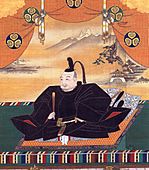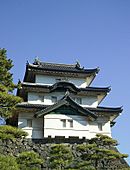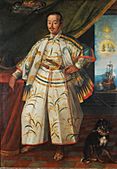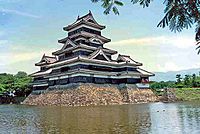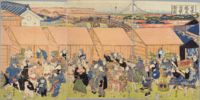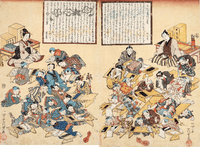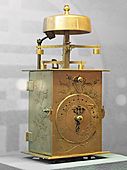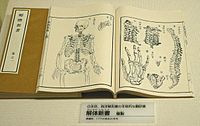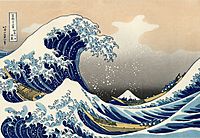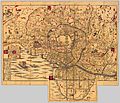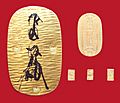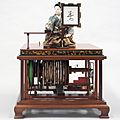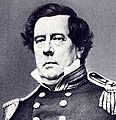Edo period facts for kids
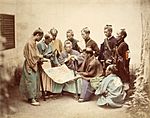 |
|---|
|
The Edo period (江戸時代, Edo-jidai), also known as the Tokugawa period (徳川時代, Tokugawa-jidai), was a long time in history of Japan. It lasted from 1600 to 1868. During these years, Japan was ruled by the Tokugawa shogunate. This government was led by a powerful military leader called a shogun.
About 300 regional lords, known as feudal lords or daimyo, also helped rule the country. This period came after the Azuchi-Momoyama period. It ended just before the Meiji Restoration, which led to modern Japan.
The Tokugawa shogunate started in a city called Edo (which is now Tokyo) in 1603. The first shogun was Tokugawa Ieyasu. Important ideas like neo-Confucianism and Shinto had a big influence during this time. The last shogun was Tokugawa Yoshinobu.
The Edo period ended with the Meiji Restoration. This was when the emperor took back control of the country. The Edo period is seen as the start of Japan's early modern age.
Contents
Key Events in the Edo Period
In 1600, a big battle called the Battle of Sekigahara happened. Tokugawa Ieyasu won this battle. This victory helped him become the most powerful leader in Japan for the next 200 years.
- 1603: The emperor made Ieyasu the shogun.
- 1605: Ieyasu stepped down as shogun. His son, Tokugawa Hidetada, became the next shogun.
- 1607: The Joseon Dynasty from Korea sent a special group to visit the Tokugawa shogunate.
- 1611: The Ryūkyū Islands became a vassal state. This meant they were under the control of the Satsuma Domain.
- 1613: A group called the "Keichō Embassy" traveled to the Americas and Europe.
- 1614: The shogunate banned Christianity in Japan.
- 1615: The Battle of Osaka took place. Ieyasu destroyed Osaka Castle and defeated the Toyotomi family.
- June 1, 1616: Ieyasu passed away at Suruga Castle.
- 1623: Tokugawa Iemitsu became the third shogun.
- 1633: The shogunate made it illegal to travel abroad. It also banned reading foreign books.
- 1635: The shogunate made a rule called sankin kotai. This meant regional lords had to live in Edo every other year.
- 1637: The Shimabara Rebellion happened. This was a revolt by peasants who were being taxed too much.
- 1638: The shogunate banned building large ships.
- 1639: New rules created a policy of Sakoku, which meant Japan was mostly closed off from the world.
- 1641: The shogunate banned all foreigners except Chinese and Dutch traders. They could only live in Nagasaki.
- 1650: With peace, a new type of educated warrior appeared. They followed bushido, the "way of the warrior."
- 1657: The Great Fire of Meireki destroyed most of Edo city.
- 1700: Popular forms of art and entertainment like Kabuki theater and ukiyo-e woodblock prints became very popular.
- December 16, 1707: Mount Fuji erupted.
- 1774: Kaitai shinsho was published. This was the first full Japanese translation of a Western medical book.
- 1787: Matsudaira Sadanobu became a very important official in the shogunate.
- 1792: A Russian envoy named Adam Laxman arrived in Nemuro.
- 1804: Another Russian envoy, Nikolai Rezanov, came to Nagasaki. He tried to start trade with Japan but was not successful.
- 1837: Ōshio Heihachirō led an uprising known as Tempo Jiken.
- 1841: The Tempo Reforms were put in place to try and fix problems in the country.
- 1854: Commodore Perry from the United States forced Japan to sign the Treaty of Kanagawa. This opened Japan to foreign trade.
- 1855: Russia and Japan started official diplomatic relations.
- September 5–6, 1864: British, French, Dutch, and American warships attacked Shimonoseki.
In 1868, Tokugawa Yoshinobu resigned as shogun. This ended the Tokugawa shogunate and the Edo period. Emperor Meiji moved his capital to Edo, which was then renamed Tokyo ("eastern capital").
Picture Gallery
-
Tokugawa Ieyasu, the first shogun of the Tokugawa shogunate.
-
A yagura, or turret, at Edo Castle in Tokyo.
-
Hasekura Tsunenaga, a Samurai and Japan's first official ambassador to the Americas and Europe (1613-1620).
-
A Wadokei, a Japanese-made clock from the 18th century.
-
Kaitai Shinsho, Japan's first book on Western anatomy, published in 1774.
-
The Great Wave off Kanagawa by Katsushika Hokusai (1760–1849).
Economy and Trade
During the Edo period, Japan's economy grew a lot. This economic growth helped Japan develop even more after the Meiji Restoration.
The rule of sankin kotai (alternate residence) made many regional lords travel to Edo. They stayed at inns along the highways. This travel made the economy more active along these routes.
Because the economy was stable, special Japanese arts and culture also grew. These included Noh theater, Kabuki theater, and ukiyo-e art.
The shogunate also had a foreign policy of isolationism. This meant Japan largely closed its borders to the outside world. Trade was very limited. The shogunate only allowed trade with China in Nagasaki. They also traded with the Netherlands on a small island called Dejima.
Related Pages
Images for kids
-
A view of Nagasaki bay, with the island Dejima on the left (1833).
-
The San Juan Bautista ship in a painting of Hasekura Tsunenaga in Rome (1617).
-
Red and White Plum Blossoms by Ogata Kōrin (1712-1716).
-
Mounting for a wakizashi (short sword) decorated with maki-e lacquer (18th century).
-
The Great Wave off Kanagawa, a full-color ukiyo-e woodblock print by Katsushika Hokusai (around 1829–1832).
-
An outer kimono for a young woman (uchikake), from 1840–1870.
-
One of the cannons from Odaiba, now at the Yasukuni Shrine.
-
Tokugawa Yoshinobu in his later life.
-
Ukiyo-e print of the kabuki actor Ichikawa Danjūrō V in the play Shibaraku, by Utagawa Kunimasa (1796).
-
An Inro and Netsuke (18th century).
See also
 In Spanish: Período Edo para niños
In Spanish: Período Edo para niños


